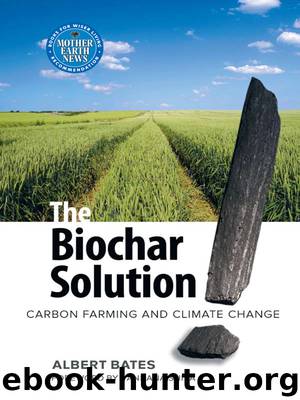The Biochar Solution by Bates Albert

Author:Bates, Albert
Language: eng
Format: epub
Tags: TEC003070, book
ISBN: 9781550924596
Publisher: New Society Publishers
Published: 2010-10-01T04:00:00+00:00
19
Compost
MIDWAY THROUGH THE FIRST CENTURY of the current era, the Roman naturalist Palladius referred to goose droppings being turned into a soil amendment called “laetamen.” A little later, Pliny the Elder mentions a wheat-like grain from the foothills of the Alps, secale, being decomposed, pro laetamine est (as if goose droppings). These references are the earliest we have of making compost. Of course, peoples whose lives were still very close to their gardens would probably not waste a lot of writing describing the ordinary processes of composting, which every child took as a daily chore, almost from the time he or she was old enough to walk.
Nor would it be without some irony that Pliny, who devoted his time to understanding how natural fertility arises in soils, would perish in a grand act of soil remineralization in which silica, calcium, magnesium, phosphorus, and potassium — elements formed in distant supernovae long before the birth of our Sun — were pumped from deep within the crust of the Earth and sprayed as fertilizer over the land. The Grand Farmer who cared nothing for Pliny but much for the soil was called by Romans “Vesuvius.”
The value of compost is at once obvious. We want to make sure that we decompose toxic garbage and plant residues to create fertile soil, and we want to retain the moisture and nutrients in the soil that plants require. If we have good soil structure, root infiltration, and oxygen diffusion, we can end our dependence on petrochemicals and grow the most nutritious, most delicious, most healthy food. Compost, and only compost, gives us that.
Unless we lived in the flood plain of the Nile or Euphrates or some other major transport vessel for silt, or excavated a bat cave for guano, compost is all we ever used to make fertilizer — prior to the discovery by Colonel Edwin Drake of a “rock oil” seep on Seneca tribal land in Pennsylvania in 1859, which led, step by step, to Fritz Haber and Carl Bosch alchemically transforming air to ammonium, and the ascendance of nitrogen fertilizers.
John Adams, second president of the United States, was walking along the Edgeware Road in London in 1786, when he observed that
there are on the Side of the Way, several heaps of Manure, an hundred Loads perhaps in each heap. I have carefully examined them and find them composed of Straw, and dung from the Stables and Streets of London, mud, Clay, or Marl, dug out of the Ditch, along the Hedge, and Turf, Sward cutt up, with Spades, hoes and shovels in the Road. . . . This may be good manure, but it is not equal to mine. . . .
Adams religiously brought to his farm in Braintree, Massachusetts, dung from Boston, ash from potash works, seaweed, and marsh mud, and added it to
what will be made in the Barn and Yard, by my Horses, Oxen, Cows, Hogs, &c, and by the Weeds, that will be carried in from the Gardens, and the Wash and Trash from the House.
Download
This site does not store any files on its server. We only index and link to content provided by other sites. Please contact the content providers to delete copyright contents if any and email us, we'll remove relevant links or contents immediately.
| Automotive | Engineering |
| Transportation |
Whiskies Galore by Ian Buxton(41524)
Introduction to Aircraft Design (Cambridge Aerospace Series) by John P. Fielding(32883)
Small Unmanned Fixed-wing Aircraft Design by Andrew J. Keane Andras Sobester James P. Scanlan & András Sóbester & James P. Scanlan(32569)
Craft Beer for the Homebrewer by Michael Agnew(17927)
Turbulence by E. J. Noyes(7690)
The Complete Stick Figure Physics Tutorials by Allen Sarah(7135)
Kaplan MCAT General Chemistry Review by Kaplan(6589)
The Thirst by Nesbo Jo(6432)
Bad Blood by John Carreyrou(6270)
Modelling of Convective Heat and Mass Transfer in Rotating Flows by Igor V. Shevchuk(6219)
Learning SQL by Alan Beaulieu(6029)
Weapons of Math Destruction by Cathy O'Neil(5821)
Man-made Catastrophes and Risk Information Concealment by Dmitry Chernov & Didier Sornette(5641)
Digital Minimalism by Cal Newport;(5384)
Life 3.0: Being Human in the Age of Artificial Intelligence by Tegmark Max(5182)
iGen by Jean M. Twenge(5155)
Secrets of Antigravity Propulsion: Tesla, UFOs, and Classified Aerospace Technology by Ph.D. Paul A. Laviolette(4974)
Design of Trajectory Optimization Approach for Space Maneuver Vehicle Skip Entry Problems by Runqi Chai & Al Savvaris & Antonios Tsourdos & Senchun Chai(4837)
Electronic Devices & Circuits by Jacob Millman & Christos C. Halkias(4739)
